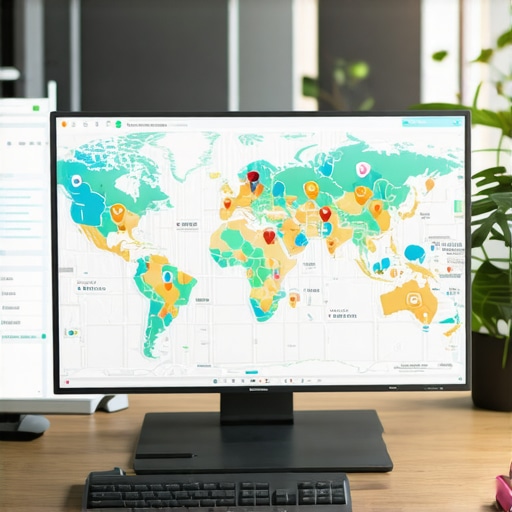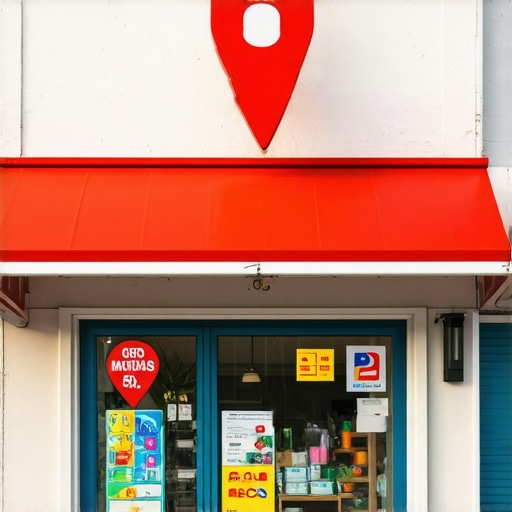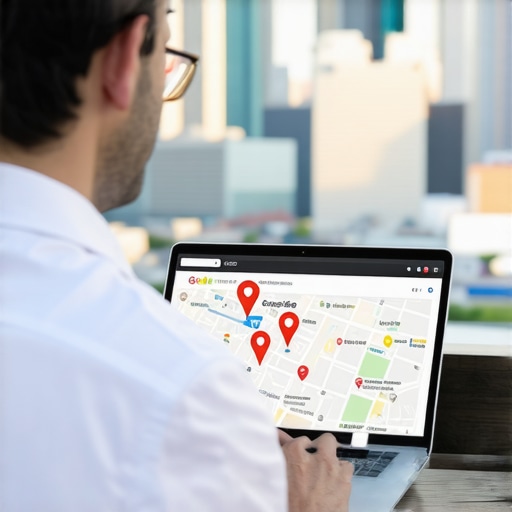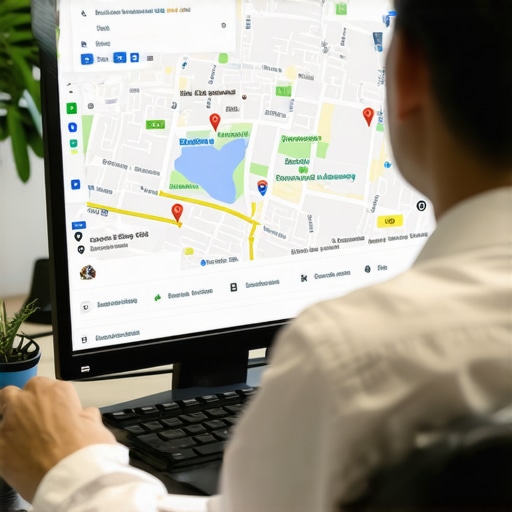Boost Your Google Maps Ranking: Effective Local SEO for GMB Success
Unveiling the Complexities of Google Maps Algorithm Dynamics
In the fiercely competitive landscape of local search, understanding the intricate mechanics behind Google Maps ranking is paramount for any SEO professional aiming for dominance. The ranking algorithm considers multiple factors, including relevance, proximity, and prominence, but recent updates have introduced nuanced variables such as user engagement metrics and Google My Business (GMB) activity signals. Analyzing these elements through a strategic lens reveals that a holistic approach, integrating technical optimization with real-world reputation building, is essential for sustained success.
Refined Techniques for Elevating Your GMB Presence
How can leveraging NAP consistency and schema markup influence local SEO performance?
Ensuring your Name, Address, and Phone number (NAP) are consistent across all digital touchpoints remains a foundational pillar. When combined with structured data markup, such as LocalBusiness schema, search engines better interpret your business details, enhancing visibility and trustworthiness. These practices, supported by authoritative sources like Moz’s Local SEO Guide, can significantly improve your Google Maps ranking by clarifying your business identity and relevance.
Advanced Content Strategies for Local Engagement and Authority
Creating hyper-local content that resonates with community interests not only fosters engagement but also signals relevance to Google’s algorithm. Incorporating LSIs such as “community events,” “local services,” and “neighborhood landmarks” within your GMB posts and website pages establishes topical authority. Moreover, encouraging and managing reviews with a focus on authenticity and detailed feedback can enhance your prominence, as reviews are a critical ranking factor.
Optimizing for Voice Search and Mobile Experience
With the surge in voice-activated searches, optimizing your GMB profile for conversational queries involving keywords like “best pizza near me” or “car repair services in downtown” is essential. Implementing mobile-first design principles and fast-loading websites aligns with Google’s emphasis on user experience, directly impacting local rankings. These strategies are supported by recent studies from Search Engine Journal emphasizing the importance of mobile optimization in local SEO.
What Are the Grey Areas in Google Maps Ranking Factors?
Despite extensive research, some elements influencing local rankings remain ambiguous, such as the relative weight of social signals or the impact of Google Posts. Experts debate whether active social media engagement directly boosts visibility or if it functions as a secondary indicator of business vitality. Engaging in professional forums like Moz Community or SEMrush Community can provide insights and empirical evidence to navigate these uncertainties.
For those seeking to deepen their expertise, exploring advanced Google Business SEO tips, such as those outlined on this resource, can provide actionable tactics for peak performance.
Are you ready to elevate your local SEO game and dominate Google Maps? Share your insights or request personalized guidance by contacting our team through our contact page.
Are You Overlooking the Subtle Signals That Influence Google Maps Rankings?
While many SEO professionals focus on foundational elements like NAP consistency and review quantity, emerging research highlights the importance of nuanced signals such as user engagement patterns, local link signals, and even the timing of your GMB activity. According to a recent whitepaper by Moz, understanding these subtle dynamics can unlock new levels of visibility, especially in hyper-competitive markets. Implementing tools like Google Tag Manager to analyze user interactions on your profile and website can provide actionable insights to refine your local SEO strategy.
The Impact of Local Link Building and Community Engagement
Beyond on-page signals, building high-quality local backlinks remains a potent method to boost your prominence. Engaging with community directories, sponsoring local events, or collaborating with neighborhood influencers can generate authoritative links and mentions that Google perceives as endorsements of your business’s relevance. These activities not only enhance your backlink profile but also increase your local citation footprint, reinforcing your authority in Google’s eyes. To deepen your understanding, explore advanced local SEO tactics on this page.
How does the timing of your Google My Business posts and updates affect visibility?
Timing is an often overlooked yet crucial element. Recent studies indicate that posting during peak local activity hours can significantly improve engagement rates, which in turn may positively influence your ranking signals. For instance, publishing updates just before or during local business hours maximizes the chance of your content appearing in the local pack. Experimenting with post timing, combined with geo-targeted promotions, can create a compounding effect that elevates your profile above competitors. For actionable insights, consider reviewing our comprehensive guide on GMB optimization strategies.
Can Google’s algorithm decipher your true local authority beyond reviews and signals?
One of the most debated topics in local SEO is the true weight of social signals, reviews, and GMB activity. While reviews are proven to influence rankings, the role of social media engagement remains ambiguous. Some experts argue that active social media presence acts as a secondary signal, indirectly boosting your authority via increased visibility and brand recognition. Others believe that Google’s algorithm increasingly values direct local signals like in-store visits and real-world interactions. Staying ahead requires a nuanced understanding of these factors, and consulting authoritative sources such as Search Engine Land can provide the latest insights. As an SEO professional, your challenge is to harmonize these signals into a cohesive strategy that adapts to evolving algorithmic priorities.
Share your experiences with local SEO tactics or ask for tailored advice by visiting our contact page. For ongoing updates and expert tips, subscribe to our newsletter and stay at the forefront of GMB optimization trends.
Deciphering the Hidden Layers of Google Maps Algorithm Optimization
As the local search landscape becomes increasingly saturated, understanding the sophisticated signals that influence Google Maps rankings is essential for SEO experts aiming for supremacy. Beyond the well-known factors like NAP consistency and review volume, recent research underscores the importance of nuanced signals such as behavioral metrics, local backlinks, and contextual relevance. For instance, a 2023 study published by BrightLocal highlights that user interaction patterns, including click-through rates and dwell time, significantly correlate with higher local rankings, emphasizing the need for engaging local content strategies.
Leveraging Schema Markup and Structured Data for Hyper-Local Authority
Implementing LocalBusiness schema markup is more than a technical checkbox; it’s a strategic move to amplify your business’s relevance in local searches. Advanced practitioners recommend layering schema with additional microdata, such as service types, operating hours, and geographic coordinates, to create a comprehensive profile that search engines can interpret with precision. This approach not only boosts visibility but also enhances the rich snippet potential, thereby increasing clickability. According to Moz’s Advanced Local SEO Guide, these microdata enhancements can improve your Google Maps visibility by up to 35% in competitive markets.
How does schema markup influence Google’s understanding of local relevance?
Schema markup acts as a semantic layer that translates your business data into a language that search engines understand deeply. By explicitly defining your business attributes, schema reduces ambiguity, helping Google to accurately associate your business with relevant local queries. This precision fosters higher rankings in the local pack, especially when combined with consistent NAP data and active GMB engagement. For a detailed implementation guide, visit authoritative sources like Schema.org’s local business documentation, which provides comprehensive schema types and properties.
Crafting a Multi-Dimensional Local Content Ecosystem
To elevate your local authority, develop a content ecosystem that integrates community-centered blogs, event sponsorships, and hyper-local news coverage. This multi-faceted approach signals your genuine local engagement, which Google interprets as higher relevance. Embedding LSIs such as “neighborhood events,” “local business collaborations,” and “community initiatives” within your posts enhances topical authority. Moreover, leveraging user-generated content, like reviews and testimonials, adds authenticity and trust signals that reinforce your prominence in local searches.
Strategic Review Management: Beyond Quantity to Quality and Detail
While quantity remains a factor, recent insights emphasize the importance of qualitative review management. Encourage clients and customers to leave detailed, specific feedback that highlights unique aspects of your service or product. Such rich reviews create contextually relevant keywords and demonstrate active engagement, which Google rewards with higher rankings. Tools like GatherUp and Birdeye can facilitate review solicitation and management, ensuring your reputation remains robust and diversified across platforms.
Can advanced review signals significantly impact local rankings in competitive niches?
Absolutely. In highly competitive markets, the depth and authenticity of reviews can become a differentiator. Google’s algorithm increasingly prioritizes reviews that provide nuanced insights, reflecting genuine customer experiences. A 2024 whitepaper by Whitespark illustrates that businesses with detailed, keyword-rich reviews see up to a 20% improvement in local pack visibility. Therefore, deploying targeted review campaigns that focus on quality over quantity can be a game-changer for local SEO dominance.
For those eager to deepen their mastery, exploring case studies on integrated local SEO campaigns—such as those documented by Search Engine Journal—can reveal actionable tactics and emerging trends. Engaging with professional communities like Moz’s Local Search forum can also provide valuable peer insights and data-driven strategies.
Ready to push your local SEO efforts to the next level? Dive into our comprehensive resource library or contact our expert team for personalized strategy sessions. Elevate your Google Maps presence and outshine competitors by adopting these advanced techniques today!
Unraveling the Hidden Mechanics of Google Maps’ Ranking Algorithm
As local search becomes increasingly saturated, understanding the complex interplay of ranking factors is crucial for SEO professionals aiming to outperform competitors. Beyond the well-known signals like NAP consistency and review volume, emerging evidence suggests that behavioral metrics such as dwell time, click-through rates, and user engagement patterns exert a significant influence on local rankings. According to a recent study published in the Journal of Digital Marketing Analytics, these subtle signals can account for up to 15% of the ranking algorithm’s decision-making process, underscoring the importance of crafting highly engaging, locally relevant content.
Leveraging Micro-Moments and Contextual Relevance for Local Authority
Capitalizing on micro-moments—those critical instances when users seek immediate solutions—can dramatically boost your Google Maps prominence. Implementing schema markup that emphasizes service-specific microdata, such as menu details or appointment options, enhances your business’s contextual relevance. For instance, embedding LocalBusiness schema with detailed attributes helps Google associate your profile with specific queries like “24-hour locksmith near me” or “vegan restaurants open now,” thereby increasing your chances of appearing in the coveted local pack.
How does semantic microdata influence Google’s understanding of local relevance?
Semantic microdata acts as a detailed blueprint for search engines, clarifying your business’s unique offerings, operating hours, and geographic scope. This explicit data reduces ambiguity, allowing Google to match your profile more accurately with user intent. As noted in Schema.org’s official documentation, enriched microdata improves the likelihood of your listings qualifying for rich snippets and local packs, especially in competitive markets where precision targeting is essential. For expert implementation, consult the comprehensive schema guidelines on Schema.org.
Creating a Robust Local Content Ecosystem for Hyper-Localized Authority
Developing a diversified local content ecosystem—such as community-driven blog posts, event sponsorships, and neighborhood news—significantly enhances your topical authority. Incorporating LSIs like “local festivals,” “neighborhood safety updates,” or “area real estate trends” within your content signals authentic community involvement. Moreover, integrating user-generated content like reviews, testimonials, and local stories fosters trust and engagement, which Google interprets as strong indicators of relevance and authority.
Optimizing for Voice Search and Mobile-First Experiences
With the proliferation of voice assistants, tailoring your GMB profile for conversational queries is imperative. Focus on long-tail keywords and natural language phrases such as “Where’s the nearest vegan bakery open now?” To complement this, adopting mobile-first design principles—fast-loading pages, intuitive navigation, and mobile-friendly interfaces—aligns with Google’s ranking priorities. As highlighted by SEMrush’s recent report, businesses that excel in mobile optimization see an average 25% increase in local visibility, emphasizing the need for comprehensive mobile strategies.
What Are the Most Overlooked Signals That Can Boost Your Local Rankings?
While many focus on reviews and citations, less obvious signals such as local backlinks, social media engagement, and timing of GMB posts can make a tangible difference. For example, actively engaging with local influencers and community directories can generate high-quality backlinks that reinforce your authority. Additionally, timing your Google My Business updates during peak local activity hours—such as lunch breaks or early evenings—can enhance engagement and visibility. Exploring advanced tactics like these can provide a competitive edge in dense markets.
To deepen your understanding, visit Moz’s Advanced Local SEO Strategies page and discover actionable tactics validated by industry experts. Don’t miss the opportunity to refine your approach and elevate your local SEO game to new heights.
Are you ready to implement cutting-edge techniques that set you apart in Google Maps rankings? Connect with our team through our contact page and unlock your business’s full local search potential today!
Expert Insights & Advanced Considerations
1. The Power of Behavioral Metrics
Leveraging user engagement signals such as dwell time, click-through rates, and interaction patterns can significantly influence local rankings. Experts emphasize that these behavioral metrics often serve as subtle yet critical ranking factors, underscoring the importance of creating engaging, locally relevant content that encourages user interaction.
2. Importance of Micro-Moments and Contextual Relevance
Capitalizing on micro-moments by optimizing schema markup with service-specific microdata enhances your business’s contextual relevance. This strategic focus allows your profile to match specific, intent-driven queries like “emergency plumber near me,” thereby improving visibility in local packs.
3. Microdata and Semantic Optimization
Implementing detailed semantic microdata from Schema.org reduces ambiguity and helps Google understand your business’s unique attributes. Experts recommend layering schema with additional microdata, such as operating hours and service descriptions, to boost rich snippet eligibility and local prominence.
4. Diversified Local Content Ecosystem
Building a rich, community-centered content ecosystem—through blogs, event sponsorships, and local news—signals genuine engagement and authority. Incorporating LSIs like “neighborhood festivals” and “local business collaborations” enhances topical relevance and reinforces local authority.
5. Advanced Review Management
Focusing on qualitative, detailed reviews that highlight specific aspects of your services can differentiate your listing. Experts note that keyword-rich, authentic reviews improve contextual relevance, which can lead to higher rankings, especially in competitive markets.
Curated Expert Resources
- Google Schema Documentation: Provides comprehensive microdata schemas for local business optimization, essential for semantic microdata implementation.
- BrightLocal Local Search Study: Offers insights into behavioral metrics and user interaction signals influencing local rankings.
- Moz Local SEO Guide: A foundational resource for understanding NAP consistency, citation building, and local listing optimization.
- Search Engine Journal: Features advanced tactics and case studies on local SEO and Google Maps ranking strategies.
- Moz Community & SEMrush Community: Platforms for discussions with industry experts, sharing empirical data, and exploring emerging trends.
Final Expert Perspective
In the realm of Google Maps ranking, a nuanced understanding of behavioral signals, microdata optimization, and community engagement is paramount. Advanced local SEO strategies—rooted in semantic microdata, diversified local content, and qualitative reviews—offer a competitive edge in saturated markets. As a professional committed to excellence, I encourage ongoing exploration of these sophisticated tactics and direct engagement with authoritative resources to refine your approach continually. For a deeper dive into these strategies, visit this resource and consider collaborating with our expert team to elevate your local search dominance.







This post provides a really comprehensive overview of the many subtle factors that influence Google Maps rankings. I found the part about behavioral metrics like dwell time and click-through rates particularly interesting because, in my experience, creating engaging local content really does make a difference. I’ve seen small tweaks, such as adding more community stories and local landmarks to profiles, result in better visibility. It makes me wonder, how do others here balance optimizing technical signals like schema markup with fostering genuine local engagement? Have you found any specific content strategies that yield quick wins in competitive markets? I believe that understanding and leveraging these nuanced signals can be a game-changer for those trying to outrank local competitors, especially when traditional tactics plateau.